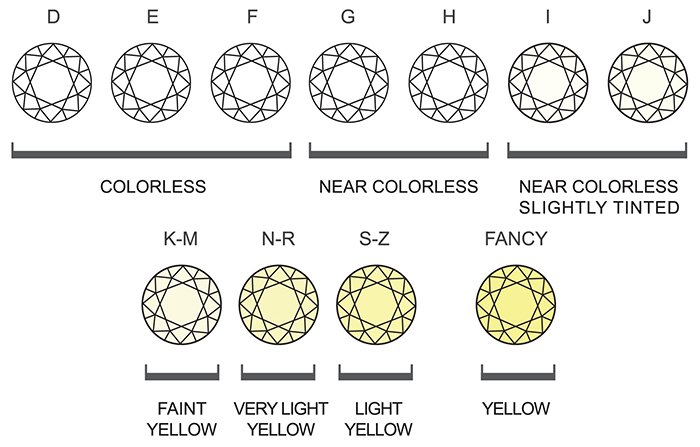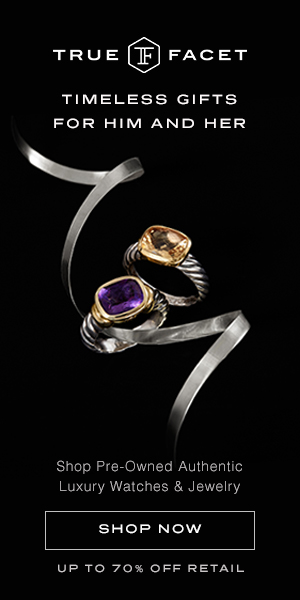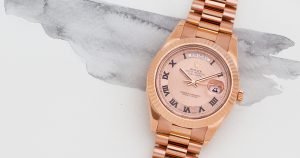Guide to Diamond Buying
The most important tips for buying diamonds are easy enough to remember as the 4 Cs: cut, color, clarity and carat weight. The hard part is remembering the standards for each of the categories. Here’s a brief description of each of the GIA grading standards and other tips to help you on your way to buying the perfect diamond.
1. Cut

The cut is often confused with the shape of the diamond (round, cushion, emerald, etc.). The cut actually refers to the proportions of the diamond and how well the diamond’s facets interact with light. The cut quality is the most important influence on the overall beauty and appearance of a diamond.
The precision of the cut maximizes the amount of light that enters the stone to be reflected back out the top of a diamond. The cut affects the brilliance and fire of the diamond. Brilliance is the reflection of the white light from the top of the diamond. Fire is the spectrum of colors that reflects from the diamond. The better the cut, the more brilliance and fire.
Often, many people are willing to sacrifice a quality cut for a larger carat weight, so many jewelers feel pressure to get maximum yield from a rough diamond. Often, a poorer cut can yield a higher carat weight in a diamond, however, the overall appearance suffers.
According to GIA standards, cut is graded from poor to excellent with five overall ratings. If size is important in your budget, a cut of good is an acceptable tradeoff to carat weight.
2. Clarity

Clarity has to do with inclusions and blemishes. Inclusions are internal flaws within the diamond while blemishes are surface flaws. When shopping for a diamond, keep in mind that flawless diamonds are extremely rare and incredibly expensive. The difference between F and VS ratings are value, but don’t necessarily affect the outward appearance of the diamond to the naked eye.
A diamond is considered flawless (FL) if, under 10x magnification, there are no visible inclusions or blemishes. If a diamond is internally flawless (IF) then there are no inclusions visible under 10x magnification. Very, very slightly included (VVS1, VVS2) means that it is difficult for the grader to see inclusions under 10x magnification. Very slightly included (VS1, VS2) means inclusions are visible under 10x magnification but are minor. If a diamond is slightly included (SI1, SI2), then the inclusions are easily visible at 10x magnification. Included diamonds (I1, I2, I3) have inclusions that are apparent to the naked eye and can negatively affect the transparency and brilliance of the stone.
3. Color

Most commonly, when speaking about the color grade of diamond, you are referring to the lack of color. The more colorless a diamond is, the more valuable—unless you are speaking about fancy color diamonds.
The GIA grades on a scale from D (colorless) to Z (light yellow). Fancy diamonds are not ranked on the same scale and fancy yellow diamonds go beyond Z color diamonds. Colorless diamonds are favored over slightly-yellow diamonds because light has a better ability to pass through the diamond, thus enhancing the appearance of the diamond.
Diamonds rated D-F are more valuable because they are extremely rare. However, diamonds rated G-I are nearly colorless. It’s difficult to tell the difference between these grades unless you have a trained eye. Further, if you choose a diamond with a lower color grade, you can mask the tint by choosing a yellow gold setting for your ring.
4. Carat Weight

One carat is equal to 200 milligrams, or .2 grams. The higher the carat of a stone, the rarer and more costly it is. The increase in price is not uniform, though. The price difference between 3 carats and 4 carats is much steeper than the difference between 2 carats and 3 carats. This is because diamonds of such a large size are much rarer and have a higher price per carat.
When shopping, if you look for stones that are just below the popular marks, like 1.8 carats instead of 2 carats, the price will be much more reasonable and the difference in size won’t be noticeable.
To keep this guide handy, download the complete version here.







